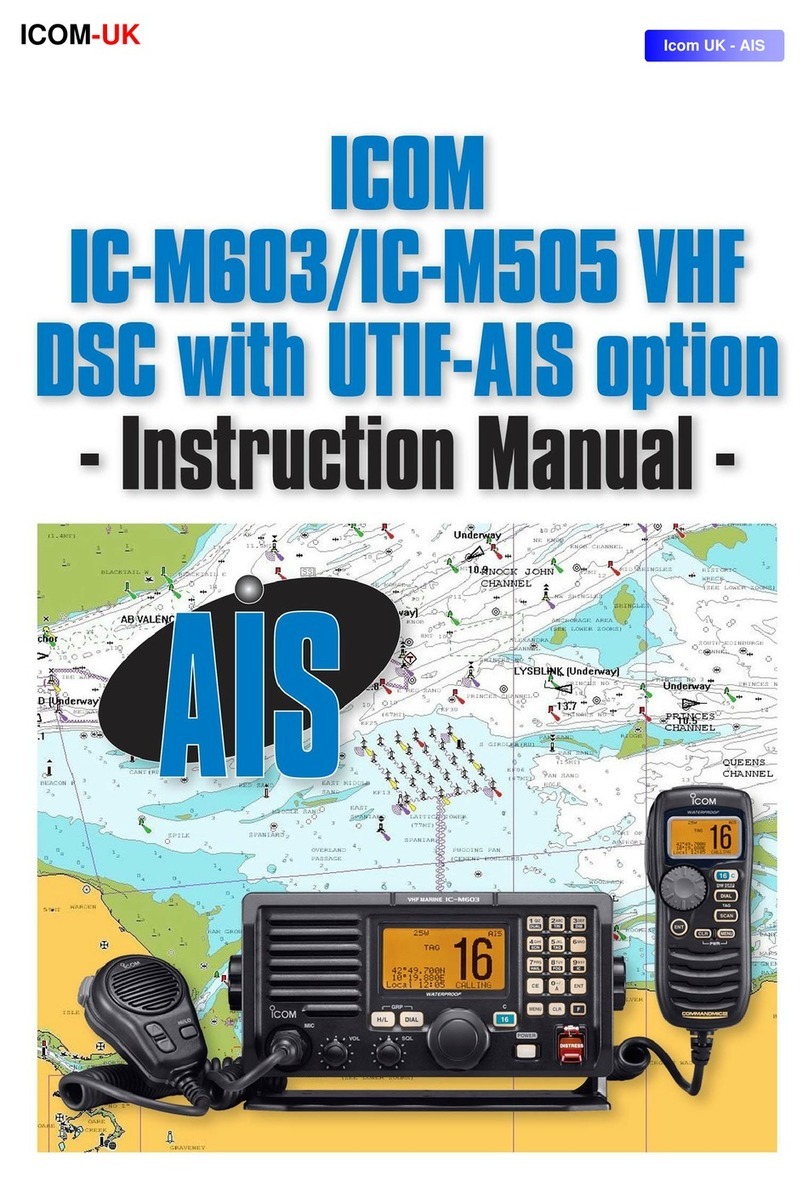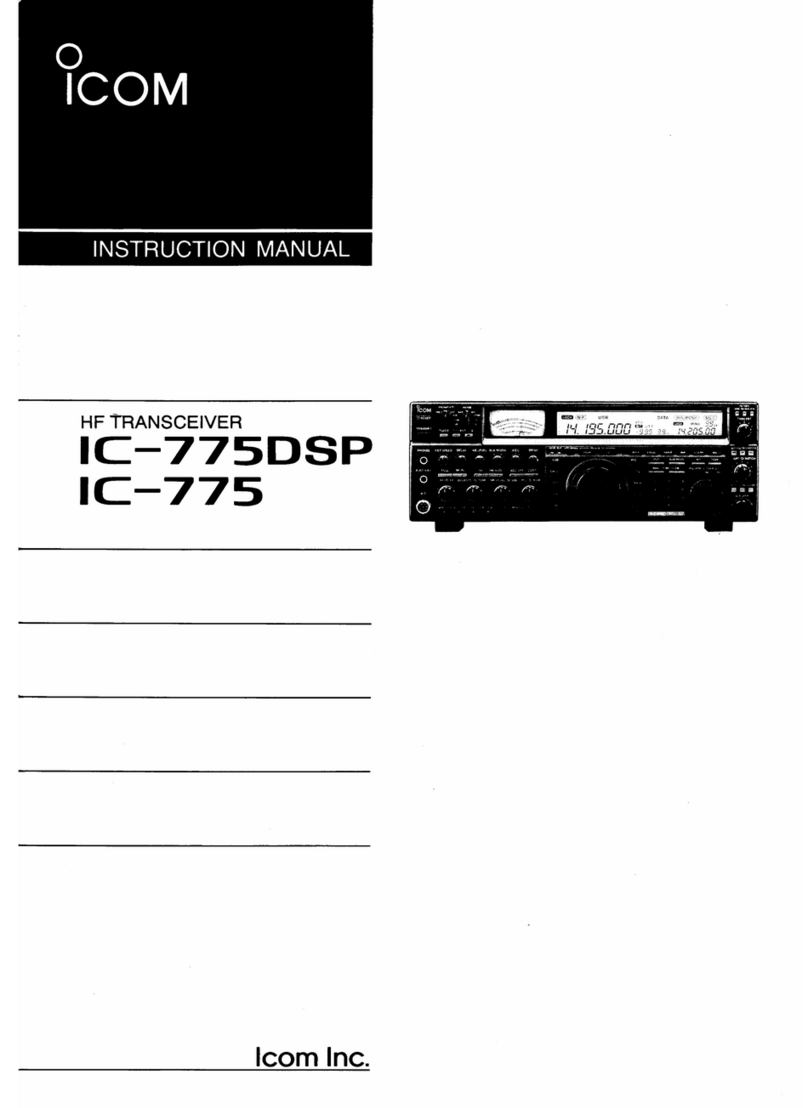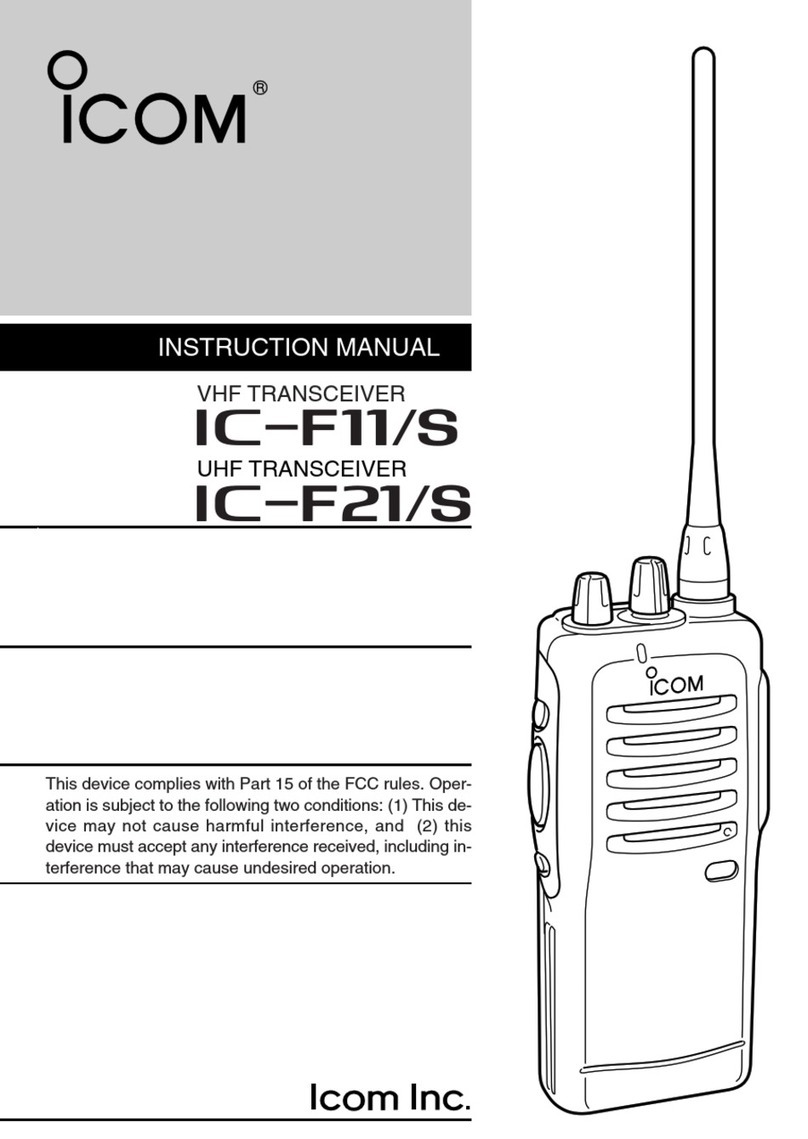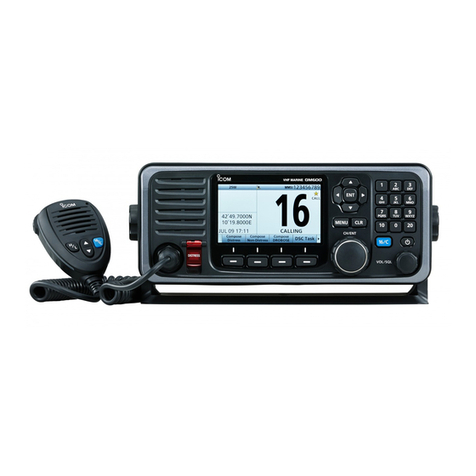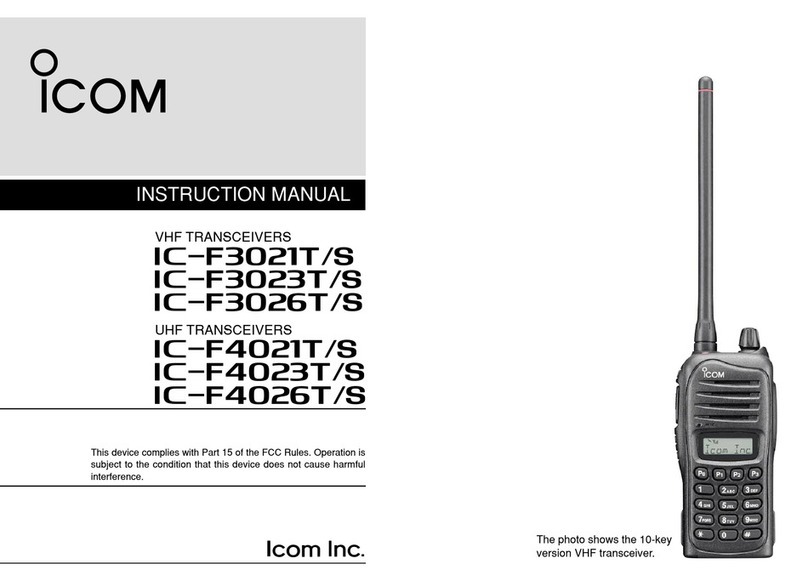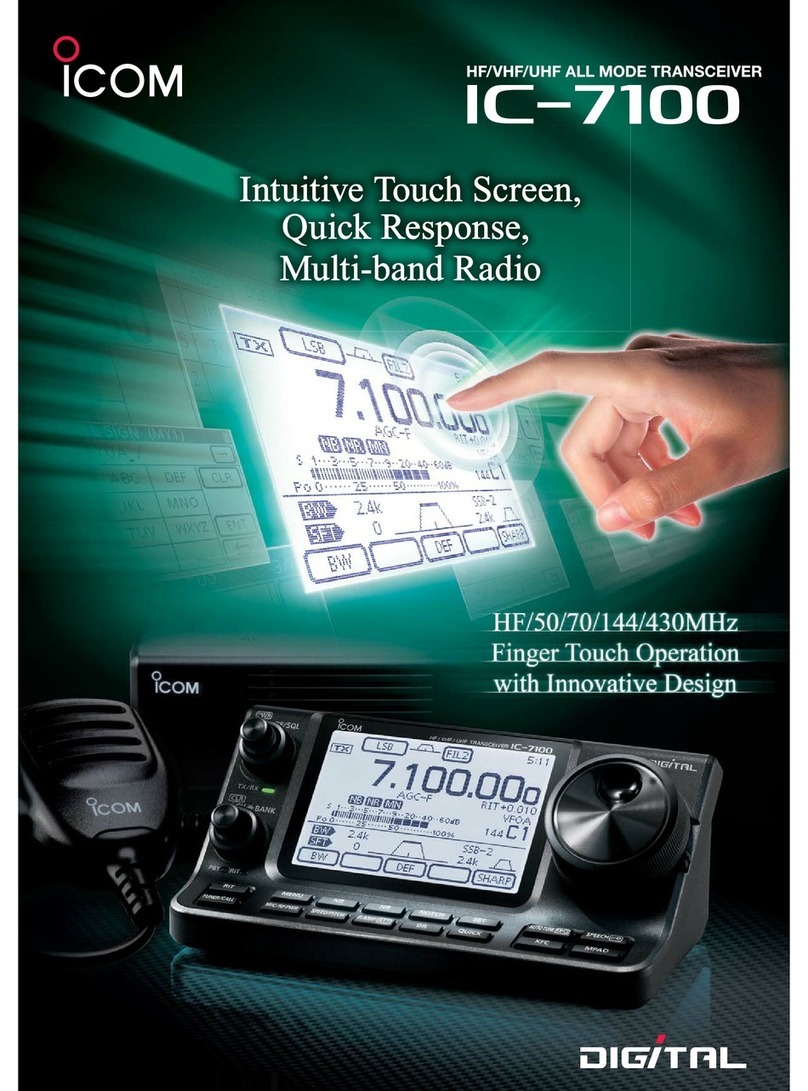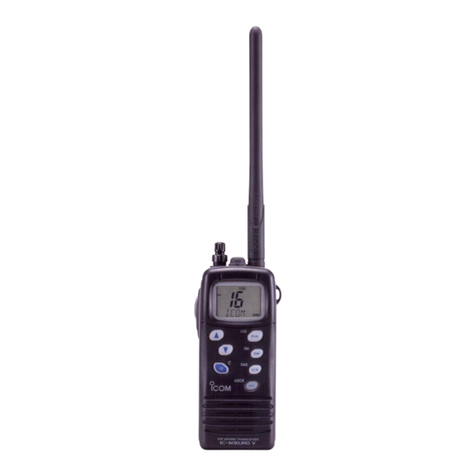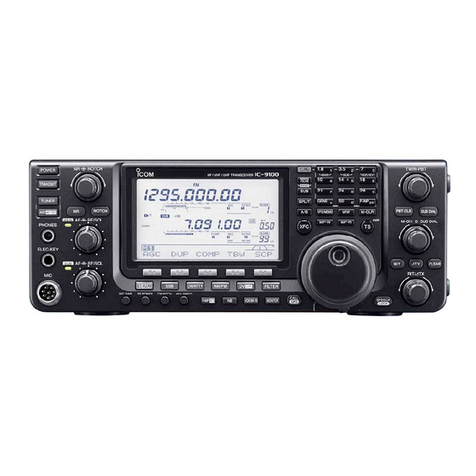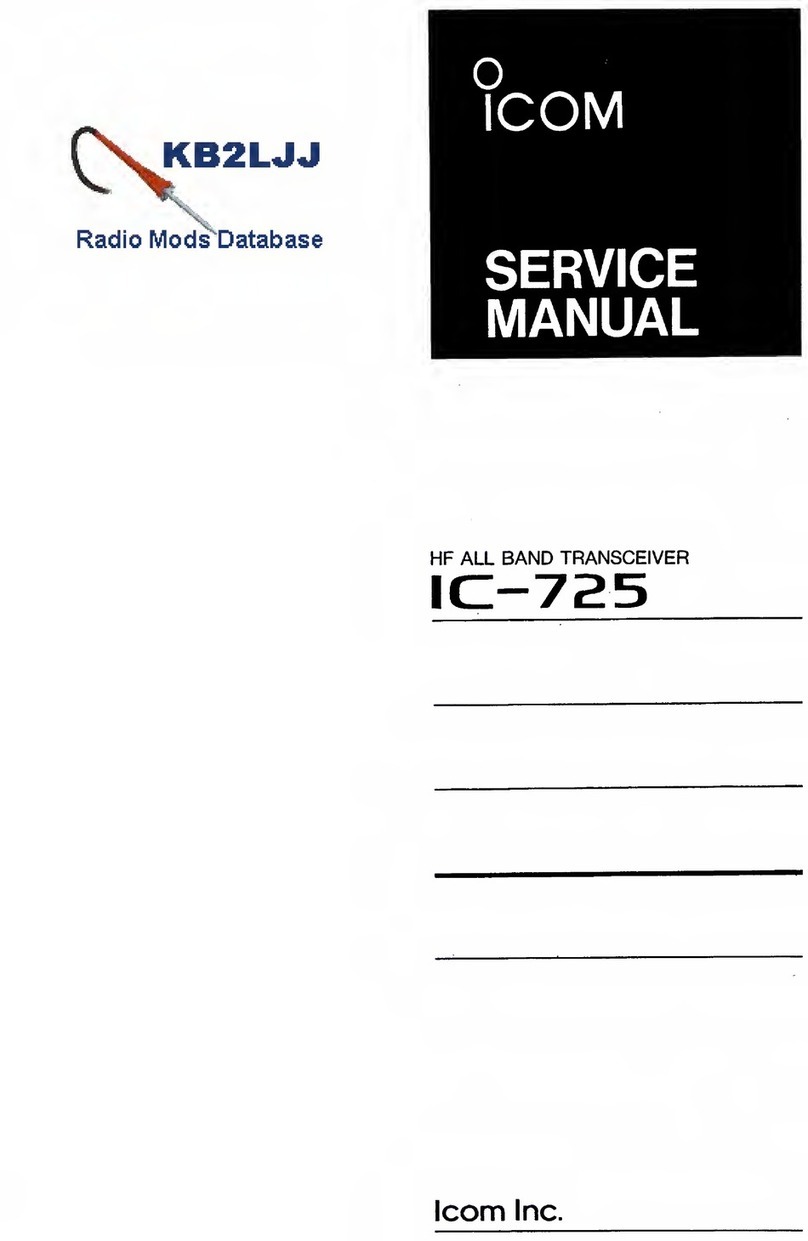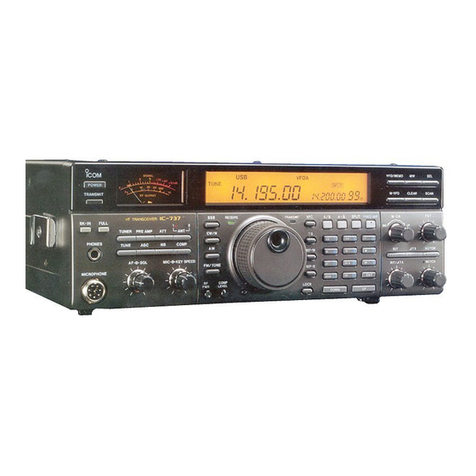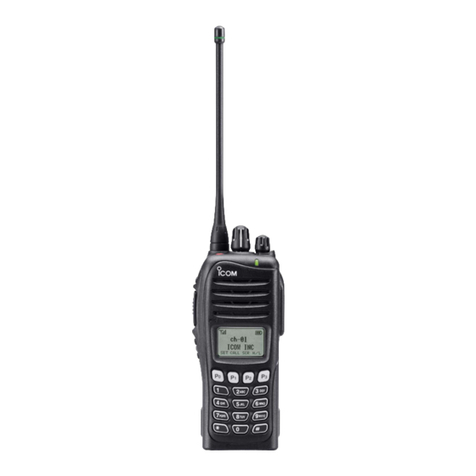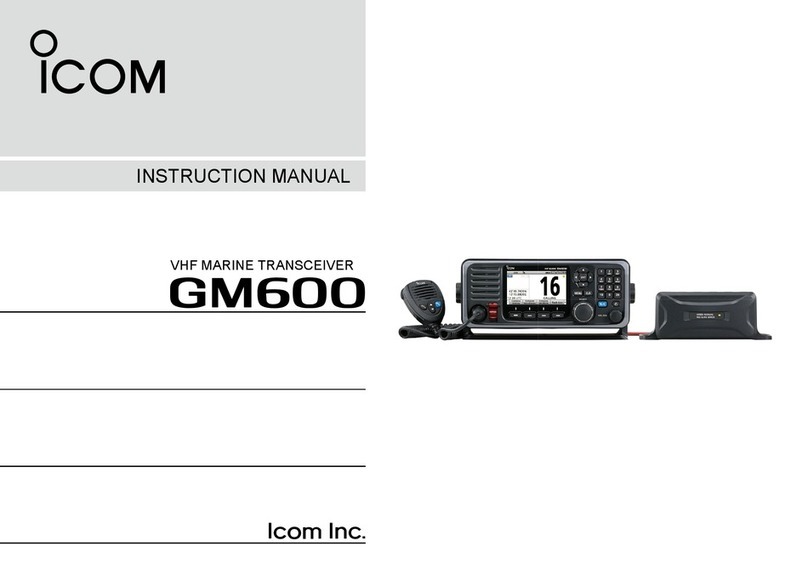Icom IC-7600 User manual

INSTRUCTION MANUAL
HF/50 MHz TRANSCEIVER
i7600

i
FOREWORD
Thank you for making the IC-7600 your radio of
choice. We hope you agree with Icom’s philosophy of
“technology first.” Many hours of research and devel-
opment went into the design of your IC-7600.
DFEATURES
MUltimate receiver performance: third-order inter-
cept (IP3) of +30 dBm (HF bands only)
MBuilt-in Baudot RTTY and PSK modulator/demodu-
lator and direct PC keyboard connection capability
for RTTY and PSK operations without a PC
MHigh resolution spectrum scope— center frequency
and fixed frequency modes, plus mini-scope dis-
plays
MUSB connectors on front and rear panels
MLarge LCD with LED backlight
IMPORTANT
READ THIS INSTRUCTION MANUAL
CAREFULLY before attempting to operate the
transceiver.
SAVE THIS INSTRUCTION MANUAL. This
manual contains important safety and operating
instructions for the IC-7600.
EXPLICIT DEFINITIONS
WORD DEFINITION
RWARNING Personal injury, fire hazard or electric
shock may occur.
CAUTION Equipment damage may occur.
NOTE
If disregarded, inconvenience only. No risk
of personal injury, fire or electric shock.
SUPPLIED ACCESSORIES
The transceiver comes with the following accessories.
Qty.
q Hand microphone ............................................ 1
w DC power cable ............................................... 1
e Spare fuse (ATC 5 A) ...................................... 1
r Spare fuse (ATC 30 A) .................................... 2
t3.5 (d) mm plug................................................. 1
q
e
t
w
r
FCC INFORMATION
• FOR CLASS B UNINTENTIONAL RADIATORS:
This equipment has been tested and found to comply
with the limits for a Class B digital device, pursuant to
part 15 of the FCC Rules. These limits are designed
to provide reasonable protection against harmful
interference in a residential installation. This equip-
ment generates, uses and can radiate radio frequency
energy and, if not installed and used in accordance
with the instructions, may cause harmful interference
to radio communications. However, there is no guar-
antee that interference will not occur in a particular
installation. If this equipment does cause harmful
interference to radio or television reception, which can
be determined by turning the equipment off and on,
the user is encouraged to try to correct the interfer-
ence by one or more of the following measures:
• Reorient or relocate the receiving antenna.
• Increase the separation between the equipment
and receiver.
• Connect the equipment into an outlet on a
circuit different from that to which the receiver is
connected.
• Consult the dealer or an experienced radio/TV
technician for help.
Icom, Icom Inc. and the Icom logo are registered trademarks of
Icom Incorporated (Japan) in the United States, the United King-
dom, Germany, France, Spain, Russia and/or other countries.
Microsoft, Windows and Windows Vista are either registered trade-
marks or trademarks of Microsoft Corporation in the United States
and/or other countries.
All other products or brands are registered trademarks or trade-
marks of their respective holders.

PRECAUTIONS
RWARNING HIGH RF VOLTAGE! NEVER
attach an antenna or internal antenna connector
during transmission. This may result in an electrical
shock or burn.
RWARNING! NEVER
operate the transceiver
with a headset or other audio accessories at high
volume levels. Hearing experts advise against continu-
ous high volume operation. If you experience a ringing
in your ears, reduce the volume or discontinue use.
RWARNING! Immediately turn the transceiver
power OFF and remove the power cable if it emits an
abnormal odor, sound or smoke. Contact your Icom
dealer or distributor for advice.
RCAUTION! NEVER put the transceiver in
any unstable place (such as on a slanted surface or
vibrated place). This may cause injury and/or damage
to the transceiver.
RCAUTION! NEVER change the internal
settings of the transceiver. This may reduce trans-
ceiver performance and/or damage to the transceiver.
In particular, incorrect settings for transmitter circuits,
such as output power, idling current, etc., might
damage the expensive final devices.
The transceiver warranty does not cover any prob-
lems caused by unauthorized internal adjustment.
RCAUTION! NEVER apply AC power to the
[DC13.8V] socket on the transceiver rear panel. This
could cause a fire or damage the transceiver.
RCAUTION! NEVER apply more than 16 V DC,
such as a 24 V battery, to the [DC13.8V] socket on
the transceiver rear panel. This could cause a fire or
damage the transceiver.
RCAUTION! NEVER
let metal, wire or other
objects protrude into the transceiver or into connectors
on the rear panel. This may result in an electric shock.
RCAUTION! NEVER block any cooling vents
on the top, rear or bottom of the transceiver.
RCAUTION! NEVER expose the transceiver to
rain, snow or any liquids.
RCAUTION! NEVER
install the transceiver in a
place without adequate ventilation. Heat dissipation
may be reduced, and the transceiver may be damaged.
RCAUTION! NEVER operate or touch the trans-
ceiver with wet hands. This may result in an electric
shock or damage to the transceiver.
DO NOT use chemical agents such as benzine
or alcohol when cleaning the IC-7600, as they can
damage the transceiver’s surfaces.
DO NOT push the PTT switch when you don’t actu-
ally desire to transmit.
DO NOT use or place the transceiver in areas with
temperatures below ±0°C (+32°F) or above +50°C
(+122°F).
DO NOT place the transceiver in excessively dusty
environments or in direct sunlight.
DO NOT place the transceiver against walls or
putting anything on top of the transceiver. This may
overheat the transceiver.
Always place unit in a secure place to avoid inadver-
tent use by children.
BE CAREFUL! If you use a linear amplifier, set the
transceiver’s RF output power to less than the linear
amplifier’s maximum input level, otherwise, the linear
amplifier will be damaged.
BE CAREFUL! The heatsink will become hot when
operating the transceiver continuously for long peri-
ods of time.
Use Icom microphones only (supplied or optional).
Other manufacturers’ microphones have different pin
assignments, and connection to the IC-7600 may
damage the transceiver or microphone.
The LCD display may have cosmetic imperfections
that appear as small dark or light spots. This is not a
malfunction or defect, but a normal characteristic of
LCD displays.
During maritime mobile operation, keep the trans-
ceiver and microphone as far away as possible from
the magnetic navigation compass to prevent errone-
ous indications.
Turn the transceiver power OFF and/or disconnect
the DC power cable when you will not use the trans-
ceiver for long period of time.
For U.S.A. only
CAUTION: Changes or modifications to this device,
not expressly approved by Icom Inc., could void your
authority to operate this device under FCC regula-
tions.
i
1
2
3
4
5
6
7
8
9
10
11
12
13
14
15
16
17
18
19
20
21

qPOWER SWITCH [POWER•TIMER] (p. ??)
While transceiver’s power is OFF:
±Push to turn the transceiver power ON.
• Turn the optional DC power supply ON in advance.
• The indicator on this switch lights green when pow-
ered ON.
While transceiver’s power is ON:
±Push momentarily to toggle the timer function
ON and OFF. (p. ??)
• The indicator on this switch lights red when the timer
function is ON.
±Push and hold for 1 sec. to turn the transceiver
power OFF.
wTRANSMIT SWITCH [TRANSMIT]
Selects transmit or receive.
• The [TX] indicator lights red while transmitting and the
[RX] indicator lights green when the squelch is open.
eHEADPHONE JACK [PHONES]
Accepts standard stereo headphones.
• Output power: 5 mW with an 8 øload.
• When headphones are connected, the internal speaker
or connected external speaker does not function.
rELECTRONIC KEYER JACK [ELEC-KEY]
Accepts a paddle to activate the internal electronic
keyer for CW operation. (p. ??)
• You can select internal electronic keyer, bug-key or
straight key operation in keyer CW-key screen. (p. ??)
• A straight key jack is located on the rear panel. See
[KEY] on p. ??.
• Keyer polarity (dot and dash) can be reversed in keyer
CW-key screen. (p. ??)
• A 4-channel memory keyer is available for your conve-
nience. (p. ??)
(dot)
(com)
(dash)
tUSB (Universal Serial Bus) CONNECTOR
(A type) [USB] (A) (p. ??)
±Insert USB-Memory* for both reading/storing a
wide variety of the transceiver’s information and
data.
• The indicator above the connectors lights or blinks
when the transceiver reads or writes to the memory
data.
• Unmount operation should be performed before re-
moving the USB-Memory* (p.??).
±Connects a PC keyboard for RTTY and PSK op-
erations.
• USB keyboards* are supported.
*: USB-Memory or USB keyboard is not supplied by
Icom.
NFront panel
TWIN-PBT
RIT/ TX
Ӡ
NOTCH
CW PITCH
VOICE MEMORY
BAL NR
AF RF/SQL
MIC GAIN RF POWER BK-IN DELAY KEY SPEED
TIMER
PHONES
ELEC-KEY
MIC
AUTO
TUNE
GENE F-INP
1.8 3 . 5
12
14
5
18
6
7
3
24
8
28
9
50
0
ENT
4
7
10
21
CHANGE
TS
XFC
SPLIT
DUAL
WATCH
MAIN
/
SUB
VFO/MEMO
MP-W
MW
MP-R
F-
6
F-
5
F-
4
F-
3
F-
2
F-
1
NRNB
PBT-CLR
APF/TPF
NOTCH
POWER
RIT
CLEAR
TX
Ӡ
SPEECH
LOCK
FILTER
REC PLAY
EXIT
/
SET
SSB CW
RTTY
/
PSK
AM/FM
MONITOR
TRANSMIT TUNER
HF/50MHz TRANSCEIVER
LOCKTX RX SPLIT
q
w
e
y
t
r
uio!0
1
1
PANEL DESCRIPTION

yMICROPHONE CONNECTOR [MIC]
Accepts the supplied or optional microphone.
• See p. ?? for appropriate microphones.
• See
p. ?? for microphone connector information.
uMIC GAIN CONTROL [MIC GAIN] (p. ??)
Adjusts microphone input gain.
• The transmit audio tone in SSB, AM and FM modes can
be adjusted independently in set mode. (p. ??)
How to set the microphone gain.
Set the [MIC GAIN] control so that the ALC meter
occasionally moves up-scale during normal voice
transmission in SSB, AM or FM mode.
MIC GAIN
Recommended level for
an Icom microphone
Increases
Decreases
Push
iAF CONTROL [AF] (inner control; p. ??)
Varies the audio output level of the speaker or
headphones.
Increases
Decreases
oRF POWER CONTROL [RF PWR] (p. ??)
Continuously varies the RF output power from mini-
mum (2 W*) to maximum (100 W*).
*AM mode: 1 W to 30 W
Increases
max. 100 W
(30 W for AM)
Decreases
min. 2 W
(1 W for AM)
Push
!0 RF GAIN CONTROL/SQUELCH CONTROL
[RF/SQL] (outer control; p. ??)
Adjusts the RF gain and squelch threshold level.
The squelch removes noise output from the speaker
(closed condition) when no signal is received.
• The squelch is particularly effective for FM. It is also
available for other modes.
• 12 to 1 o’clock position is recommended for any setting
of the [RF/SQL] control.
• The control can be set as ‘Auto’ (RF gain control in
SSB, CW and RTTY; squelch control in AM and FM)
or squelch control (RF gain is fixed at maximum) in set
mode as follows. (p. ??)
MODE SET MODE SETTING
AUTO SQL RF GAIN + SQL
SSB, CW
RTTY/PSK RF GAIN SQL RF GAIN + SQL
AM, FM SQL SQL RF GAIN + SQL
• When setting as RF gain/squelch control
Maximum
RF gain
S-meter
squelch
Noise squelch (FM mode)
Squelch is
open.
RF gain
adjustable
range
Recommended level
• When functioning as RF gain control
(Squelch is fixed open; SSB, CW, RTTY only)
Minimum RF gain
Adjustable
range
Maximum
RF gain
• When functioning as squelch control
(RF gain is fixed at maximum.)
Squelch is
open.
S-meter
squelch
S-meter squelch
threshold
Noise squelch
threshold
(FM mode)
Shallow Deep
Noise squelch (FM mode)
While rotating the RF gain control, noise may be
heard. This comes from the DSP unit and does not
indicate an equipment malfunction. 2
1
PANEL DESCRIPTION
1
2
3
4
5
6
7
8
9
10
11
12
13
14
15
16
17
18
19
20
21
Other manuals for IC-7600
5
Table of contents
Other Icom Transceiver manuals
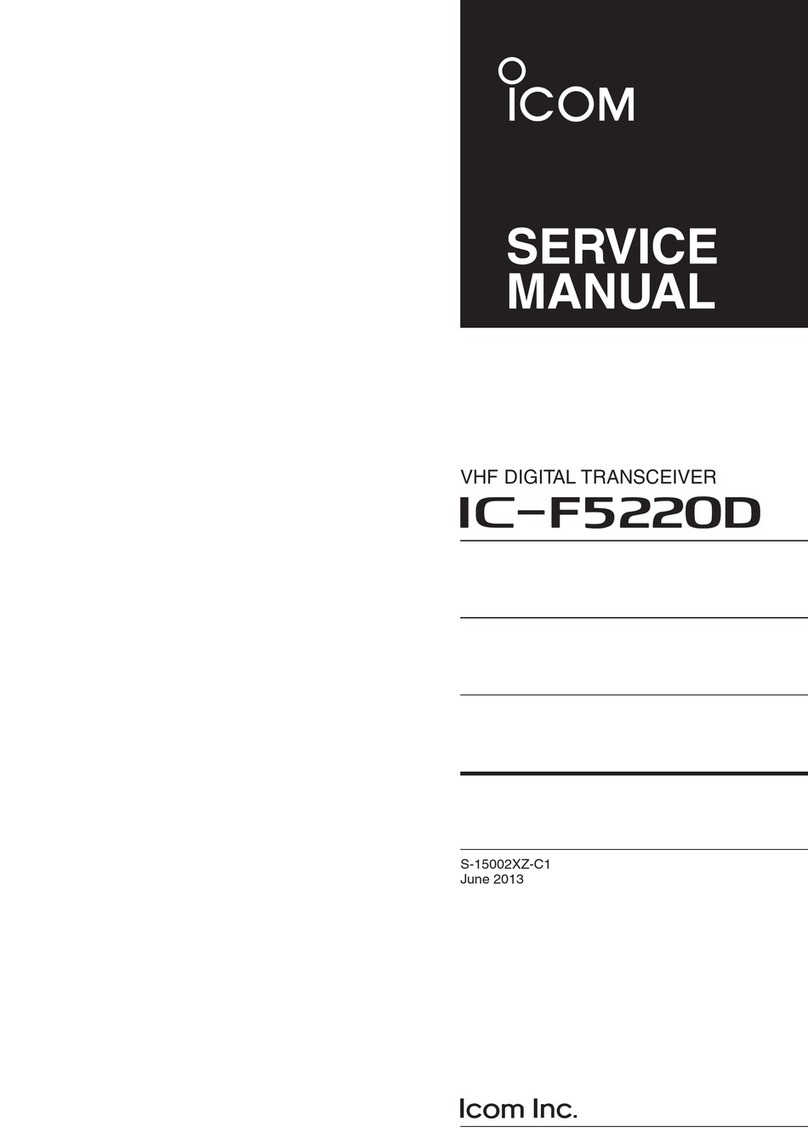
Icom
Icom IC-F5220D User manual
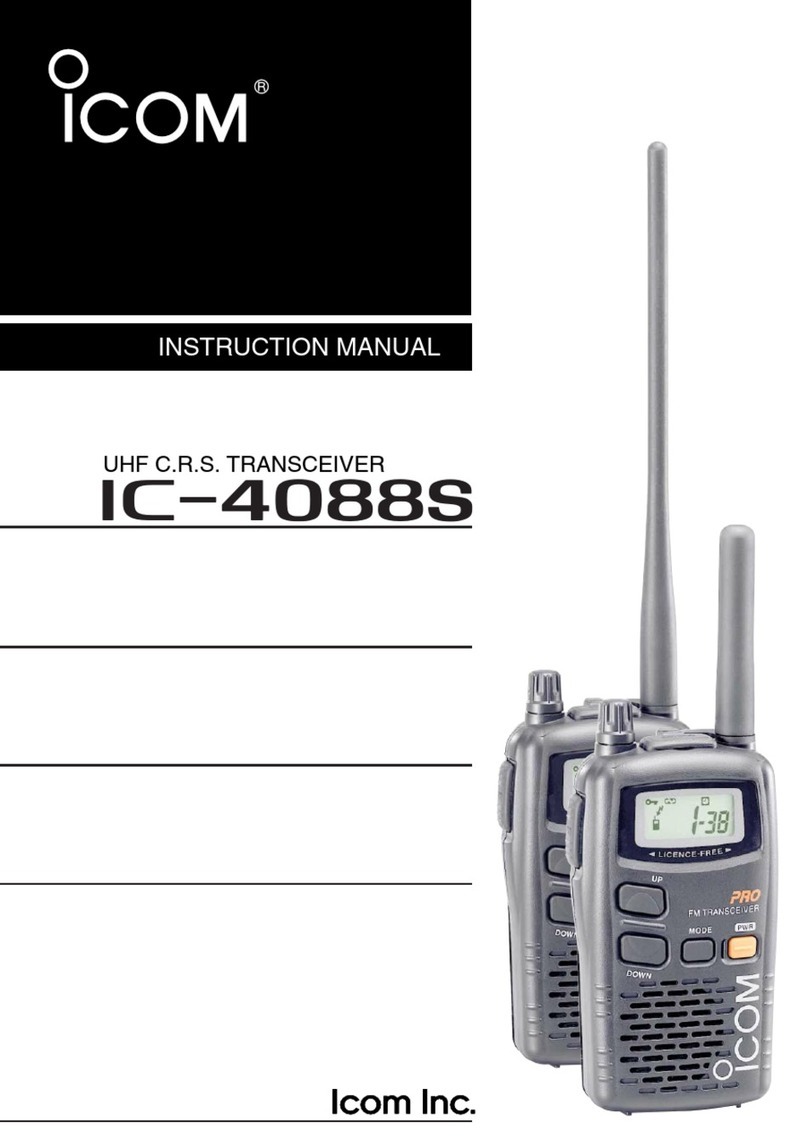
Icom
Icom IC-4088S User manual
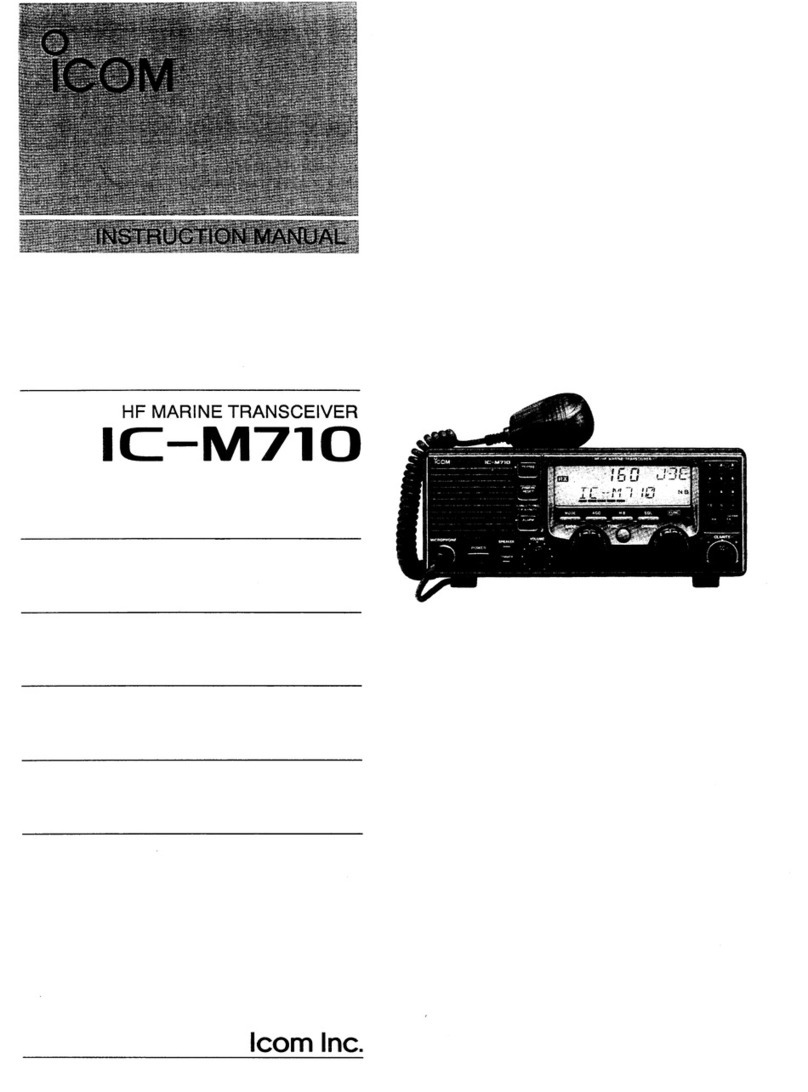
Icom
Icom IC-M710 User manual
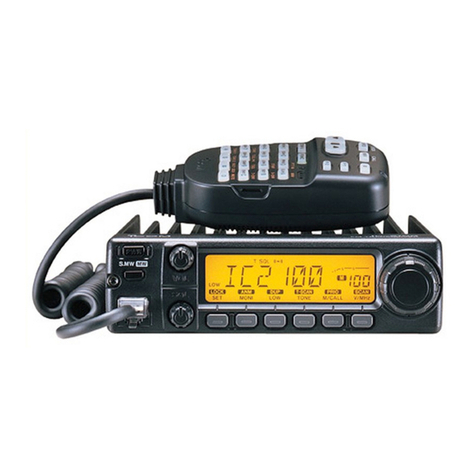
Icom
Icom IC-2100H User manual

Icom
Icom IC-M91D Installation and operating instructions

Icom
Icom IC-V8000 User manual
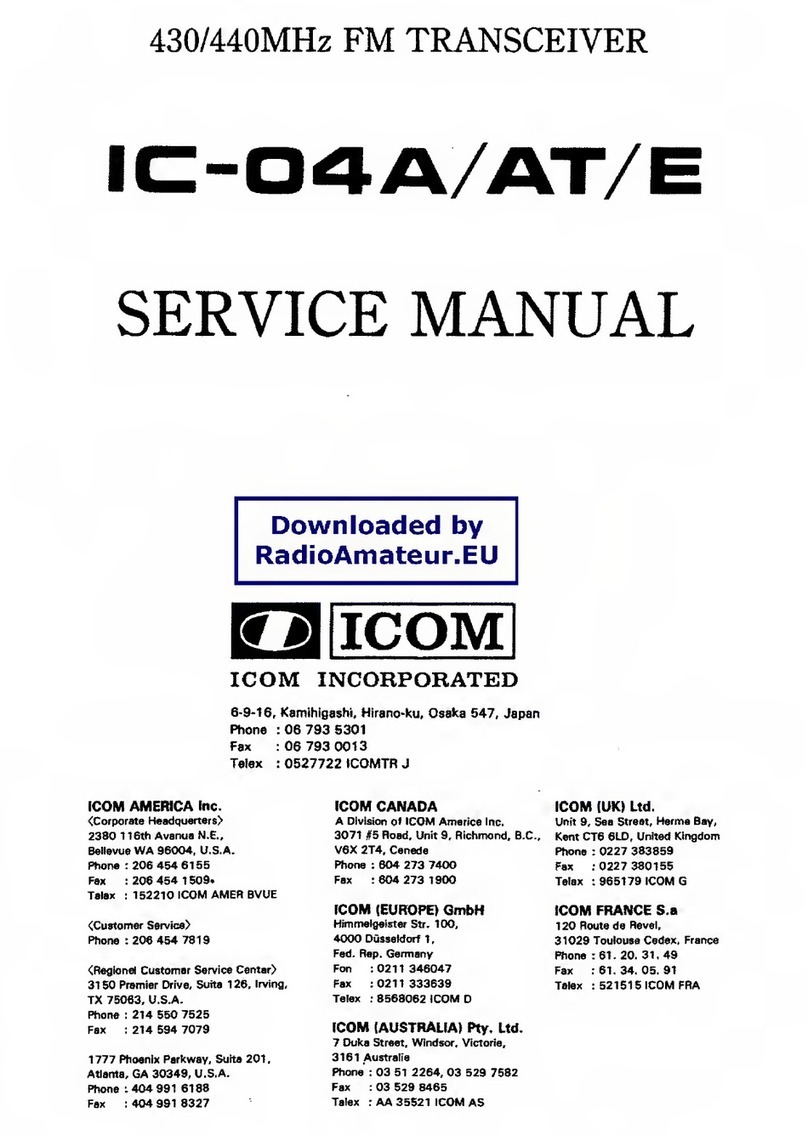
Icom
Icom IC-04A User manual
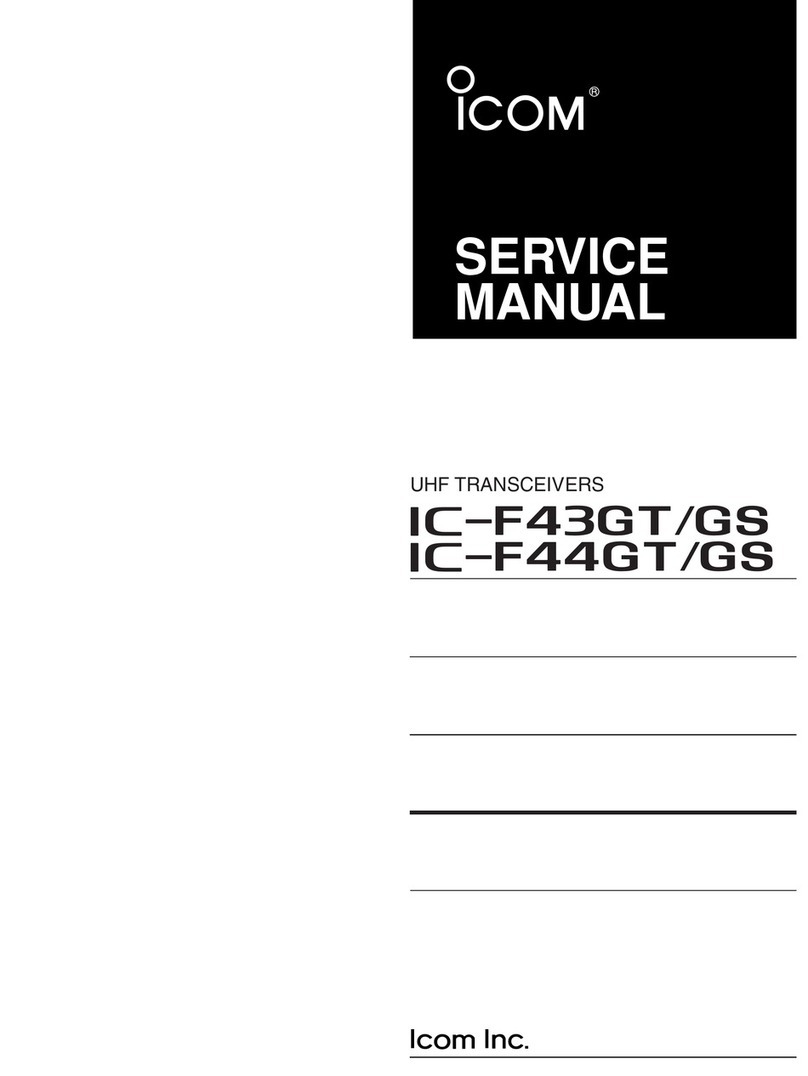
Icom
Icom IC-F43GT User manual

Icom
Icom IC-2710H User manual
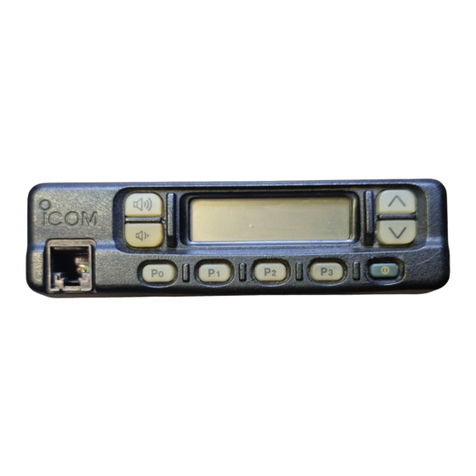
Icom
Icom IC-F420 User manual
Popular Transceiver manuals by other brands

Kenwood
Kenwood ProTalk TK-3201 instruction manual

City Theatrical
City Theatrical SHoW DMX SHoW Baby user manual

Standart Horizont
Standart Horizont HX407 owner's manual

B&G
B&G V90S quick start guide

VictelGlobal
VictelGlobal ALK300 series Operation manual

Cactus
Cactus Wireless Flash Transceiver V6 user manual
